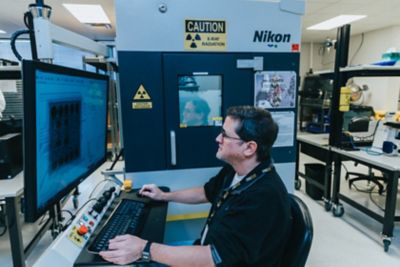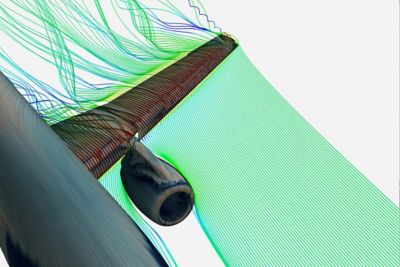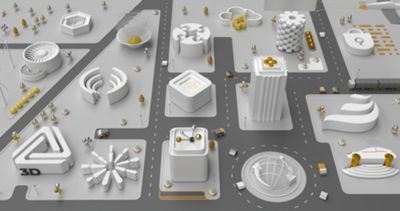-
United States -
United Kingdom -
India -
France -
Deutschland -
Italia -
日本 -
대한민국 -
中国 -
台灣
-
Ansysは、シミュレーションエンジニアリングソフトウェアを学生に無償で提供することで、未来を拓く学生たちの助けとなることを目指しています。
-
Ansysは、シミュレーションエンジニアリングソフトウェアを学生に無償で提供することで、未来を拓く学生たちの助けとなることを目指しています。
-
Ansysは、シミュレーションエンジニアリングソフトウェアを学生に無償で提供することで、未来を拓く学生たちの助けとなることを目指しています。
自由曲面光学とは
光学部品には、さまざまな形状やサイズがあります。従来レンズは球面形状で、長年にわたって製造可能な唯一の光学面でした。しかし技術が進化し、より複雑な曲率と高度な光学特性を持つ非球面の光学面が登場しました。
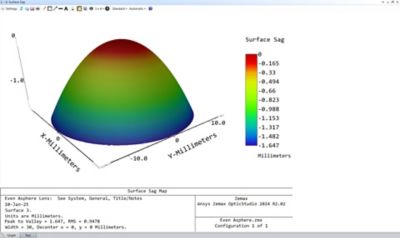
球面レンズの表面プロファイル
自由曲面光学は、多数のレンズや非軸上コンポーネントを必要としてきた光学システムにとって、理想的なアプローチです。現代のレンズ設計、光学エンジニアリング、そして光学コンポーネントの製造技術により、これまでにない革新的かつ複雑な構造の要素が実現可能となり、より小型でより優れた光学性能を実現しています。
なぜ自由曲面光学が必要なのか
近年の光学システムには小型化が求められるケースが多くありますが、複数のレンズを詰め込むことで、光学性能や画像品質に悪影響を及ぼす可能性があります。自由曲面光学のアプローチを用いることで、球面レンズに比べて優れた光学性能が得られ、光学素子内のレンズ、リフレクター、またはミラーの数を削減することが可能になります。これにより、メーカーはより小型の光学部品を製造できるようになり、同時に光学的な収差を補正する手段も得られます。こうした利点から、自由曲面光学は航空宇宙、自動車、コンシューマー向けエレクトロニクスといった業界で活用されています。
自由曲面光学の主な用途には、以下のようなものがあります。
- ヘッドアップディスプレイ(HUD):
- 望遠鏡
- イメージングシステム
- ビームシェーピングおよび照明
- 車両用ヘッドライト
- 赤外線レンズ
- AR/VRヘッドセット
- 回折光学素子
- 収差を伴う波面
自由曲面光学設計は、既存の光学システムを最適化・改善するために用いられることもありますが、多くの場合、自由曲面がなければ商業的に実現不可能です。
たとえば、人工衛星に搭載される望遠鏡では、光を導くために複数のミラーが必要です。この望遠鏡の小型化にあたって自由曲面を用いなければ、画像品質が著しく低下してしまいます。そのため、自由曲面光学なしで高度な望遠鏡を開発するのは、ほぼ不可能と言っても過言ではありません。
HUDにおいても、優れた性能を発揮するためには自由曲面光学が不可欠です。なぜなら、反射型の光学部品は車両のダッシュボード下には収まりきらないためです。こうしたシステムを自由曲面なしで構成しようとすると、現在よりもはるかに多くのミラーが必要になり、所定のスペースに収めるのは現実的ではありません。
自由曲面光学は、車両の外部照明においても有用であり、対向車のドライバーを照らさずに最適な配光を実現しながら、使用する部品数を削減することが可能です。また、運転者に広い視野を提供するために車載ミラーにも使用されており、AR/VRヘッドセットにおいては、高性能かつ小型な部品が求められることから、ほぼ標準的に採用されています。つまり、自由曲面光学がなければ、多くの多くの新しい光学技術は実現できないでしょう。
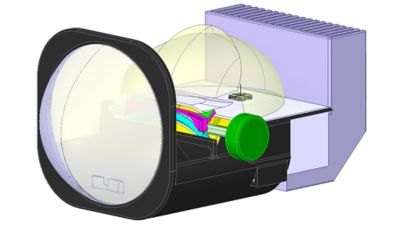
車載用投影レンズ
自由曲面光学の種類
現在開発されている非球面の光学面は増加傾向にあり、これまでにないほど複雑な形状が利用可能になっています。最初に開発された非球面レンズの形式は「非球面(アスフェリック)」でした。今日では、対称性を持たない自由曲面も設計および製造が可能となっており、先進的な光学・フォトニクス分野において、より高い柔軟性が実現しています。
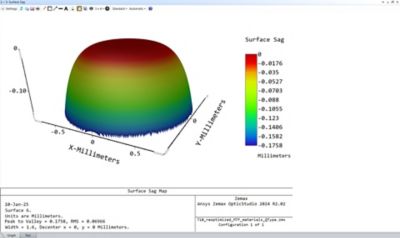
非球面レンズの表面プロファイル
自由曲面光学は、対称性を持たず、曲率が一定でない高性能な光学面であり、非球面より複雑なジオメトリを持ちます。これは広義の分類であり、レンズの表面形状を数学的に記述した内容に基づいて命名される、さまざまな種類の自由曲面を含みます。
それぞれの自由曲面のクラス内では、数学的な関数に従う限り、さまざまな表面形状が存在し得ます。
現在よく使われている自由曲面の一例として、以下のようなものがあります。
- XY多項式
- ゼルニケ多項式
- チェビシェフ多項式
- Q型自由曲面
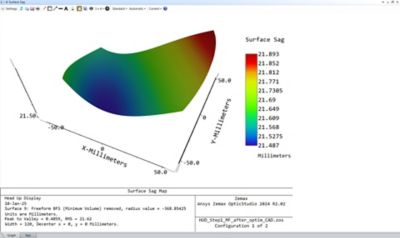
自由曲面レンズの表面プロファイル
光学システムに使用される自由曲面の種類は、そのシステムの要件や最終的な用途によって決まります。自由曲面レンズの表面プロファイルには、x方向およびy方向の変化が多く存在するため、XY多項式は多様な形式で作成することが可能です。
ゼルニケ自由曲面は、用途に応じた自由度を持つ自由曲面パターンを、異なるモジュール状の「ブロック」を組み合わせて形成することができるため、設計者の間で人気のある選択肢です。組み合わせの幅が広いため、ゼルニケ多項式は多くの自由曲面光学において非常に柔軟性の高い選択肢となっています。
ゼルニケ多項式の構成要素は円形ベースであるため、左右方向や上下方向に強い非対称性を持つ矩形状のレンズ設計には、XY多項式やチェビシェフ面プロファイルの方がより適しています。Q型自由曲面は比較的新しい自由曲面レンズの設計手法であり、Ansysのソフトウェアソリューションを用いて設計することが可能です。これらは、エンドユーザーからのリクエストに応じて開発されました。
自由曲面光学の製造と設計
自由曲面光学はシミュレーションを通じて設計されますが、複雑な表面形状のレンズを製造するために用いる材料によって、必要となる製造プロセスは異なります。金属を含む基板など、多くの自由曲面光学部品の製造には、CNC加工やダイヤモンドターニング(ダイヤモンド加工とも呼ばれます)といったツールが使用されます。
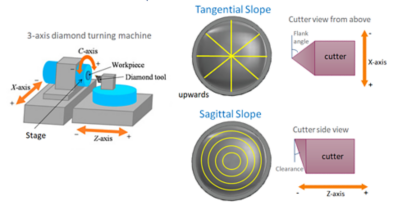
ダイヤモンドターニングの模式図
ダイヤモンドターニングでは、ダイヤモンドの先端があらゆる方向に高速回転し、レンズ上の不要な材料を除去しながら、表面プロファイルを形成します。プラスチック製の光学部品に対しては、ダイヤモンドターニングによる金型インサートを含む各種射出成形技術を用いることで、特定の形状を持つ自由曲面の製造が可能です。その後、表面粗さやその他の表面特性・光学特性については、測定機器や干渉計を用いた計測によって評価され、レンズが所定の性能を満たし、目的とする光学特性を備えていることが確認されます。
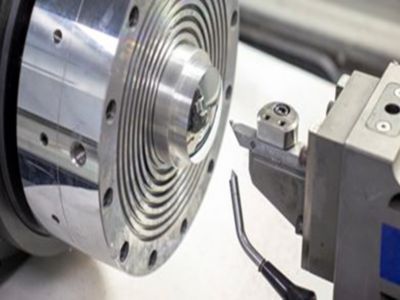
ダイヤモンド切断装置
主な製造上の課題は、設計手法で定義された特性に対して、加工プロセスがどれだけ高い精度で対応できるかという点にあります。シミュレーションによって設計された光学系は、高度に最適化されており、理想的な設計として位置付けられます。しかし、実際に製造され始めると、製造プロセスにおける公差が最終製品の特性や表面形状に影響を及ぼす可能性があります。
使用される製造技術によって、さまざまな製造上の制約が存在します。設計プロセスは高い堅牢性を備え、これらの公差を設計段階で考慮に入れる必要があります。そうすることで、光学部品の設計と製造後の性能との間にギャップが生じるのを防ぐことができます。
自由曲面光学を設計するための高度なシミュレーションソフトウェアの活用
高度なシミュレーションツールを使用することで、球面、非球面、あるいは自由曲面といった、あらゆる種類の光学素子を設計することが可能です。Ansys Zemax OpticStudioやAnsys Speosといったソフトウェアを用いれば、さまざまな用途に応じた多様な自由曲面のシミュレーションを容易に実行できます。現在のところ、自由曲面の選定はエンジニアによって手動で行われていますが、将来的にはAIアルゴリズムによって自動的に選定されるようになるでしょう。
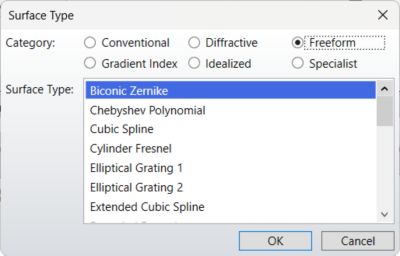
自由曲面の選定

Ansys Zemax OpticStudioによる自由曲面設計の活用例
OpticStudioソフトウェアは、自由曲面光学システムの設計において非常に効率的なツールです。内蔵されたシーケンシャルモードにより、設計内の各光学面を手動で選定することなく、イメージングシステムの設計が可能なためです。Speosは、設計内で複雑な照明パターンを解析・決定するために活用できます。
OpticStudioには、自由曲面に関する内蔵制約機能が備わっており、製造業者の技術力や製造プロセスにおける公差を考慮した設計が可能です。また、OpticStudioには特定の数学関数に依存せずに最適化や公差解析が行える自由曲面オプションが搭載されており、エンジニアは設計内のグリッド制御点を操作することで、完全に自由な曲面形状を作り出すことができます。
さらにAnsysのシミュレーションでは、自由曲面光学がさらされる環境全体も考慮されており、局所的な圧力や温度といった外的要因を含めた包括的な視点から解析を行うことができます。
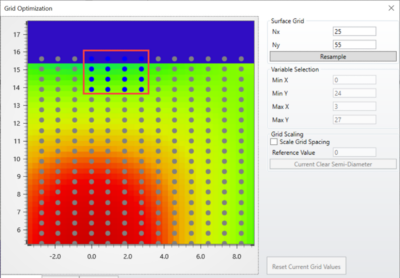
真の自由曲面
高度なシミュレーションツールを使用することで、エンジニアは自由曲面設計の各種パラメータを調整し、それが光学部品の実際の性能にどのような影響を及ぼすかを確認できます。これには、製造プロセスに起因する可能性のある不規則性も含めて評価することが可能です。シミュレーションを活用することで、エンジニアはシステムが品質管理をクリアできるか、期待される性能目標を達成できるか、さらには量産が可能かどうかを事前に確認できます。
Ansysは、あらゆる自由曲面光学のシナリオに対応するための幅広いシミュレーションツールを提供しています。Ansysのソリューションは、製造上の要素や、製造工程中に発生し得る公差・感度を考慮した堅牢な光学部品設計を可能にします。
Ansysのソフトウェアソリューションが、自由曲面光学の開発にどのように貢献できるかについては、ぜひ当社の技術チームまでお問い合わせください。
関連リソース
さあ、始めましょう
エンジニアリング課題に直面している場合は、当社のチームが支援します。豊富な経験と革新へのコミットメントを持つ当社に、ぜひご連絡ください。協力して、エンジニアリングの障害を成長と成功の機会に変えましょう。ぜひ今すぐお問い合わせください。






